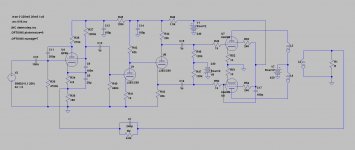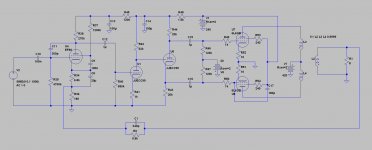To my big surprise, even good smd caps sucks at treble freq. Behaving like more like chokes, or just nF´s instead of µF´s.
please be specific - there are "bad" ceramics for some audio signal purposes
uF ceramic smd will be hi-k dielectric, very large V coefficient of C, often piezoelectric
but "smd" could also include bi-polar Al eletcrolytics or PPS, Acrylic, PEN film types too
uF ceramic smd will be hi-k dielectric, very large V coefficient of C, often piezoelectric
but "smd" could also include bi-polar Al eletcrolytics or PPS, Acrylic, PEN film types too
Well Wavebourn I think if you are familiar with Russian tech then you know that the caps also varied from year to year and sometimes even from model to model because sometimes there was a surplus of good army stock and sometimes the army needed so much that the civil factories were left with scrap literally.
one of the priboi's has all good caps, the other one had most of the big GAVNO electrolytics dead or missing contact/capacitance and the smaller blue ones were with bad coating , the very same cap in others only sometimes some of their parts got worse treatment I dunno why.
Did you measure them? All I suggested, if they are still good and alive, they are decent and better leave them alone.
Before we go down a rabbit hole, what specifically do you mean by "decoupling caps"?
Makes absolutely, positively no difference. There is nothing at all in a tube amp that puts any kind of strain or concern upon any of the limiting properties or parasitic attributes of a capacitor.
Therefore, choose polyester because it will most likely be smaller and cheaper. It will sound exactly the same.
Tim
Therefore, choose polyester because it will most likely be smaller and cheaper. It will sound exactly the same.
As a coupling cap with a nice, low f3, yes, absolutely. Thus my question.
hah funny Wavebourn mentioned schematic and a member named schematic appeared 😀
oh but yes why do you say the schematic is the weak point? what in it exactly makes it weak?
oh but yes why do you say the schematic is the weak point? what in it exactly makes it weak?
oh but yes why do you say the schematic is the weak point? what in it exactly makes it weak?
Show it here and we'll help you. 🙂
As a coupling cap with a nice, low f3, yes, absolutely. Thus my question.
Or a coupling cap with a modest f3, or an audio filter cap with a midband f3, or.... 😉
(Reports of any low-k dielectric having distortion are largely exaggerated, and in any case, we wouldn't be using tubes if we wanted minimal distortion, so distortion is no excuse on this forum.. 🙂 )
Tim


many thanks to:
http://www.jogis-roehrenbude.de/Oldies/Priboj/Priboy-Verstaerker.jpg
Just in case you can't read German, it has a reputation for evenly "rounded" sound and somewhat heavy bass. A real "workhorse" for a banquet hall, etc..
Last edited:
I would think the EF86 Screen resistor would be 390k-470k. Also the cathode resistors need to be raised to around 1k. Grid has too much resitance......
Screen resistor is 1.2M for sure. I think the input stage is supposed to be grid current biased instead of cathode biased, or kind of a mixed bias between those two.
Why would the designer do that?
(The bias supply is not -240V, I just copied it and forgot to edit it. I also left out the bias pot and extra grounding resistors.)
Plenty of things to fix or improve.
Why would the designer do that?
(The bias supply is not -240V, I just copied it and forgot to edit it. I also left out the bias pot and extra grounding resistors.)
Plenty of things to fix or improve.
MrCurwen, resistor values are as follows (numbers from your Spice drawing):
R34 = 6.8 Kohm
R37 = 1.2 Mohm
R39 = 4.7 Mohm
R34 = 6.8 Kohm
R37 = 1.2 Mohm
R39 = 4.7 Mohm
well I've listened to the Priboi with some decent quality recordings also flac's etc.I have to say I think much of this " rounded" or "squared" sound or any other kind of food flavor sound etc is not actually scientific nor real.
I have musical hearing myself have been singing in choir for many years I have listened to some good quality amps and most recently this Russian tube thing and quite frankly it sounds light and nice , much depends on the input signal and how it's configured.
the only real difference is when you listen to low quality recordings like mp3/mp4 and all other kinds of lossy codecs or when the original recording is simply made in the 1940's if the recording is good quality it sounds good.
I use some paper coned old time LOMO speakers and if you don't drive the speaker to mechanical limits and distortion it sounds really natural and nice.
I honestly get the feeling that most amplifiers are judged rather poorly mostly because the listener had them in a configuration were they couldn't perform any better, like a bad listening room, rattling and vibrating objects around , bad speaker cabinets that resonate , bad signal etc.
the things i personally enjoy is music and look out for are clear mids , much detail all across the spectrum , tight and precise bass and basically strong enough psu that doesn't sag under heavy loads.
i think it's a sign of good amplification if you can hear multiple instruments in the background not just the main ones being loud and everything else non existent.
I would still love to hear Wavebourn's take on he Priboi schematic🙂
I have musical hearing myself have been singing in choir for many years I have listened to some good quality amps and most recently this Russian tube thing and quite frankly it sounds light and nice , much depends on the input signal and how it's configured.
the only real difference is when you listen to low quality recordings like mp3/mp4 and all other kinds of lossy codecs or when the original recording is simply made in the 1940's if the recording is good quality it sounds good.
I use some paper coned old time LOMO speakers and if you don't drive the speaker to mechanical limits and distortion it sounds really natural and nice.
I honestly get the feeling that most amplifiers are judged rather poorly mostly because the listener had them in a configuration were they couldn't perform any better, like a bad listening room, rattling and vibrating objects around , bad speaker cabinets that resonate , bad signal etc.
the things i personally enjoy is music and look out for are clear mids , much detail all across the spectrum , tight and precise bass and basically strong enough psu that doesn't sag under heavy loads.
i think it's a sign of good amplification if you can hear multiple instruments in the background not just the main ones being loud and everything else non existent.
I would still love to hear Wavebourn's take on he Priboi schematic🙂
Last edited:
Thanks elektroj.
I fixed R34 and the output bias voltage. Seems there are no other errors.
So, the floor is open to suggestions.
I fixed R34 and the output bias voltage. Seems there are no other errors.
So, the floor is open to suggestions.
Attachments
Last edited:
out of curiosity MrCurwen , do you own a priboi and wish to modify/upgrade it , is that the reason you are modelling it in spice?
uF ceramic smd will be hi-k dielectric, very large V coefficient of C, often piezoelectric
but "smd" could also include bi-polar Al eletcrolytics or PPS, Acrylic, PEN film types too
Smd ceramics are trash, everybody is familiar with this
But smd electrolytes being trash too, that was surprise
- Status
- Not open for further replies.
- Home
- Design & Build
- Parts
- polyester or polypropylene or other??

